
Breton is a Southwestern Brittonic language of the Celtic language group spoken in Brittany, part of modern-day France. It is the only Celtic language still widely in use on the European mainland, albeit as a member of the insular branch instead of the continental grouping.

Celtic music is a broad grouping of music genres that evolved out of the folk music traditions of the Celtic people of Northwestern Europe. It refers to both orally-transmitted traditional music and recorded music and the styles vary considerably to include everything from traditional music to a wide range of hybrids.

Brittany is a peninsula, historical country and cultural area in the north-west of modern France, covering the western part of what was known as Armorica during the period of Roman occupation. It became an independent kingdom and then a duchy before being united with the Kingdom of France in 1532 as a province governed as a separate nation under the crown.

Trifle is a layered dessert of English origin. The usual ingredients are a thin layer of sponge fingers or sponge cake soaked in sherry or another fortified wine, a fruit element, custard and whipped cream layered in that order in a glass dish. The contents of a trifle are highly variable and many varieties exist, some forgoing fruit entirely and instead using other ingredients, such as chocolate, coffee or vanilla. The fruit and sponge layers may be suspended in fruit-flavoured jelly, and these ingredients are usually arranged to produce three or four layers. The assembled dessert can be topped with whipped cream or, more traditionally, syllabub.
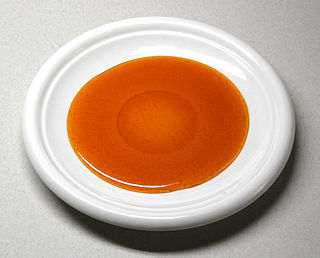
Caramel is an orange-brown confectionery product made by heating a range of sugars. It can be used as a flavoring in puddings and desserts, as a filling in bonbons, or as a topping for ice cream and custard.

A crêpe or crepe is a very thin type of pancake. Crêpes are usually one of two varieties: sweet crêpes or savoury galettes. They are often served with a wide variety of fillings such as cheese, fruit, vegetables, meats, and a variety of spreads. Crêpes can also be flambéed, such as in crêpes Suzette.

A custard pie is any type of uncooked custard mixture added to an uncooked or partially cooked crust and baked together. In North America, custard pie commonly refers to a plain mixture of milk, eggs, sugar, salt, vanilla extract and sometimes nutmeg combined with a pie crust. It is distinctly different from a cream pie, which contains cooked custard poured into a cooled, precooked crust. In the United Kingdom, the comical or political act of pieing is conventionally done with a "custard pie". Some common custard pies include pumpkin pie, lemon and buttermilk chess pie, coconut cream pie, and buko pie. True custard is defined as a liquid thickened with eggs. Due to the often large number of whole eggs in custard pie, it is a very rich pie.

A mille-feuille, also known by the names Napoleon in North America, vanilla slice in the United Kingdom, and custard slice, is a dessert made of puff pastry layered with pastry cream. Its modern form was influenced by improvements made by Marie-Antoine Carême.

German chocolate cake, originally German's chocolate cake, is a layered chocolate cake filled and topped with a coconut-pecan frosting. Originating in the United States, it owes its name to an English-American chocolate maker named Samuel German, who developed a formulation of dark baking chocolate that came to be used in the cake recipe. It is not German by nationality. Sweet baking chocolate is traditionally used for the cake's flavor, but few recipes call for it today. The filling and/or topping is a custard made with egg yolks and evaporated milk; once the custard is cooked, coconut and pecans are stirred in. Occasionally, a chocolate frosting is spread on the sides of the cake and piped around the circumference of the layers to hold in the filling. Maraschino cherries are occasionally added as a garnish.
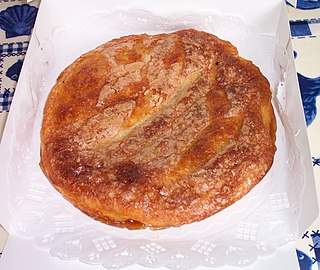
Kouign-amann is a sweet Breton cake, made with laminated dough. It is a round multi-layered cake, originally made with bread dough, containing layers of butter and incorporated sugar, similar in fashion to puff pastry, albeit with fewer layers. The cake is slowly baked until the sugar caramelizes and the butter expands the dough, resulting in its layered structure. A smaller version, kouignette, is similar to a muffin-shaped, caramelized croissant.

Galette is a term used in French cuisine to designate various types of flat round or freeform crusty cakes, or, in the case of a Breton galette, a pancake made with buckwheat flour usually with a savoury filling. Of the cake type of galette, one notable variety is the galette des Rois eaten on the day of Epiphany. In French Canada the term galette is usually applied to pastries best described as large cookies.

The Bretons are a Celtic ethnic group native to Brittany, north-western France. They trace much of their heritage to groups of Brittonic speakers who emigrated from southwestern Great Britain, particularly Cornwall and Devon, mostly during the Anglo-Saxon settlement of Britain. They migrated in waves from the 3rd to 9th century into Armorica, which was subsequently named Brittany after them.
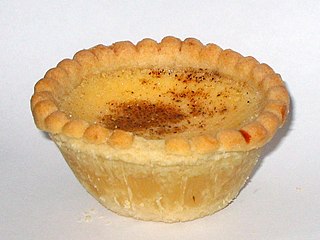
Custard tarts or flan pâtissier/parisien are a baked pastry consisting of an outer pastry crust filled with egg custard.

Sponge cake is a light cake made with egg whites, flour and sugar, sometimes leavened with baking powder. Some sponge cakes do not contain egg yolks, like angel food cake, but most of them do. Sponge cakes, leavened with beaten eggs, originated during the Renaissance, possibly in Spain. The sponge cake is thought to be one of the first of the non-yeasted cakes, and the earliest attested sponge cake recipe in English is found in a book by the English poet Gervase Markham, The English Huswife, Containing the Inward and Outward Virtues Which Ought to Be in a Complete Woman (1615). Still, the cake was much more like a cracker: thin and crispy. Sponge cakes became the cake recognized today when bakers started using beaten eggs as a rising agent in the mid-18th century. The Victorian creation of baking powder by English food manufacturer Alfred Bird in 1843 allowed the addition of butter to the traditional sponge recipe, resulting in the creation of the Victoria sponge. Cakes are available in millions of flavours and have many recipes as well. Sponge cakes have become snack cakes via the Twinkie.
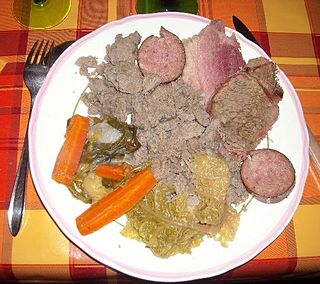
Kig ha farz is a cooked dish consisting of various meats simmered in a broth with a buckwheat flour based pudding. It is eaten traditionally in Brittany, more specifically around Léon in the region situated west from Morlaix to Brest. This dish, which is quite similar to a pot-au-feu, was once considered a dish for the poor and peasantry. The name in Breton literally means "meat and stuffing".

Upper Brittany is the eastern part of Brittany, France, which is predominantly of a Romance culture and is associated with the Gallo language. The name is in counterpoint to Lower Brittany, the western part of the ancient province and present-day region, where the Breton language has traditionally been spoken. However, there is no certainty as to exactly where the line between 'Upper' and 'Lower' Brittany falls.

Crème brûlée or crème brulée, also known as burnt cream or Trinity cream, and virtually identical to the original crema catalana, is a dessert consisting of a rich custard base topped with a layer of hardened caramelized sugar. It is normally served slightly chilled; the heat from the caramelizing process tends to warm the top of the custard, while leaving the center cool. The custard base is traditionally flavored with vanilla in French cuisine, but can have other flavorings. It is sometimes garnished with fruit.
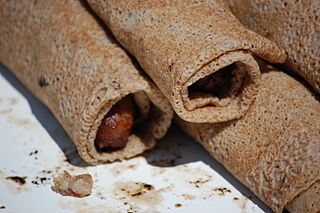
A galette-saucisse is a type of French street food item consisting of a hot sausage, traditionally grilled, wrapped in a type of crepe called galette de sarrasin or Breton galette. The French region known as Upper Brittany is the traditional homeland of galette-saucisse, especially the department of Ille-et-Vilaine and some parts of its bordering departments like Côtes-d'Armor, Morbihan, Loire-Atlantique, Mayenne and Manche.
Richard Bertinet is a renowned Breton baker who now bakes and teaches in Bath, Somerset. He has campaigned for "real bread" and he was acclaimed as a food champion by the BBC in 2010.


















